
PROVIDENCE WATER HISTORY

PROVIDENCE WATER HISTORY
Beginning in 1636, when Roger Williams founded Providence on the east bank of the Providence River, the only drinking water available was derived from private wells. In 1773, a fountain society was formed to supply water to the town through a system of underground hollowed out logs. But as the population began to swell in the 1800's, the City Council knew the only solution was to locate a reliable water supply.
The early development of a water supply system for Providence met the same opposition for improvements of this nature as experienced by Boston, New York, Cincinnati and many other communities. When the construction of a public water works was first submitted to the voters of these cities, they rejected the proposal by a large majority. Providence experienced the same voter trend.
On March 21, 1853, the first committee was appointed by the City Council with instructions to examine and report on a suitable public water supply for the City. The committee reported back to the Council that the most suitable solution would be to take water from the Ten Mile River in East Providence. The City Council authorized the purchase of certain lands and rights necessary to develop the supply, but the voters rejected the proposition. Five different committees made six reports between 1853 and 1868. The final report to the Council emphasized the need for an abundant supply of water for the development and protection of the community.
On February 15,1869, the question was submitted to the voters for the fourth time, and finally the question of introducing water into Providence from the Pawtuxet River was approved.
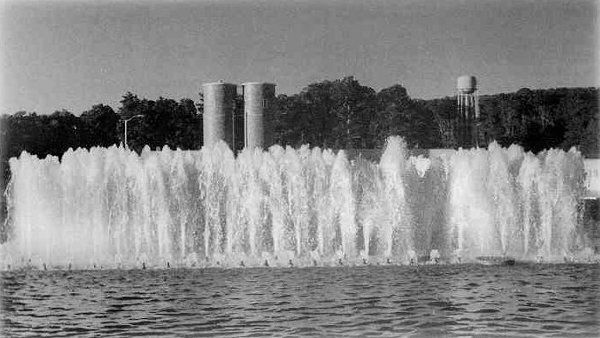
Aerators at Scituate are used to improve the taste of the water, as well as to remove any unpleasant odors.
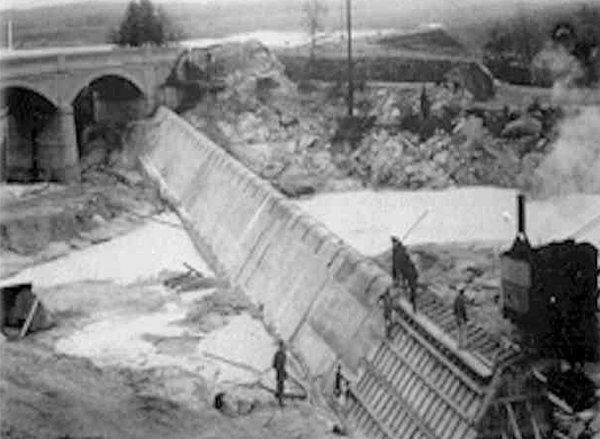
The Gainer Dam was constructed in 1925 to safely manage the amount of water that fills the reservoir. As a matter of routine, excess amounts of water are carefully allowed to flow over the spillway into the Pawtuxet River.
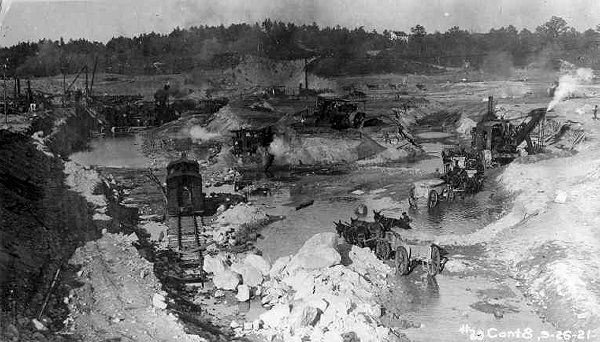
General view of Kent Dam's core trench and construction equipment, looking east.
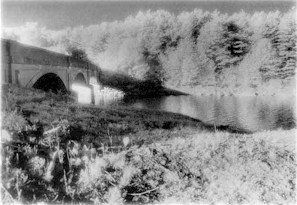
Area of the spillway today.
The original water supply was obtained from the Pawtuxet River at Pettaconsett in the City of Cranston. Construction was started in the spring of 1870 and the first service pipe was opened on December 1, 1871. From 1871 to 1902, water was pumped directly from the river and discharged into the system without any purification treatment. In 1906, the City's first slow sand filter water purification system was constructed.
After the completion of the filters, water was drawn from the river, filtered, and pumped again to an open distribution reservoir called Sockanosset, with a capacity of 55 million gallons. This reservoir was located in what is known today as the Glen Woods Development in the City of Cranston. From this reservoir, the water flowed by gravity to consumers and to the Hope Reservoir in Providence, the second open type, which had a capacity of 76 million gallons. Hope High School is now located on the site of this former reservoir. Pumps located at this storage basin supplied water to the system and to the old Fruit Hill Reservoir, which had a capacity of 25 million gallons. This open distribution reservoir was located in North Providence on the land now occupied by Our Lady of Fatima Hospital. The special fire service system in the high valued business district and congested manufacturing district was supplied from the Fruit Hill Reservoir. The three open distribution reservoirs provided a reserve storage of 156 million gallons.
The original water works, although owned and controlled by the City of Providence, operated in the capacity of a metropolitan system. In addition to Providence, it served Cranston, Warwick, Johnston and North Providence.
As early as 1910, only 39 years after the completion of this supply, it was apparent that with the growth of Providence and the extension of the distribution system in nearby communities, it would not be many years before the flow from Pettaconsett would be inadequate to meet the increased demands. In fact, for a number of years the consumption during extremely dry weather exceeded the natural flow of the river, and the shortage was made up from water stored in small reservoirs owned by companies operating mills further upstream.
The constant menace of a possible shortage of water resulted in the appointment by the City Council in January 1913 of a committee to investigate the possibility of developing an increased water supply. Legislation was enacted under which the present supply was built.
The Pawtuxet River served the City of Providence from the time water first reached residents' homes in 1871 to 1926 when the deteriorating quality of water, affected by disposal of residential and industrial pollutants into the area's ground water system, became a serious problem.
By 1926, health issues and increasing demand on the Pawtuxet River prompted a milestone Providence City Council decision to develop a new modern water supply system. This consisted of the construction of a large reservoir and treatment plant on the north branch of the Pawtuxet River in the town of Scituate. This system, which today still provides water to most of the State of Rhode Island, consists of the main Scituate Reservoir supply and its five tributary reservoirs.
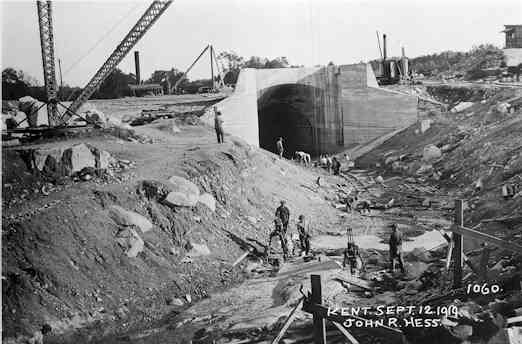
Construction of the reservoir main dam — river diversion approach channel.
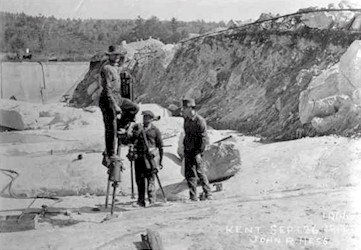
Engineers at work on the cut-off trench.
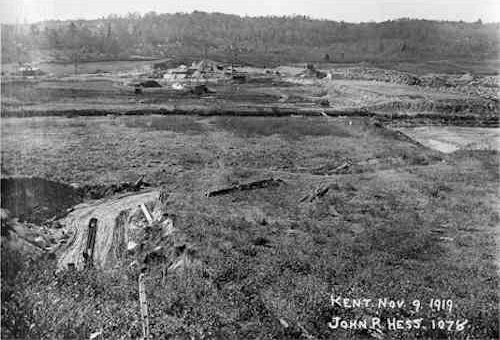
Future location of the Kent Dam, looking west.
Today, the body of Scituate Reservoir
would lie to the right.
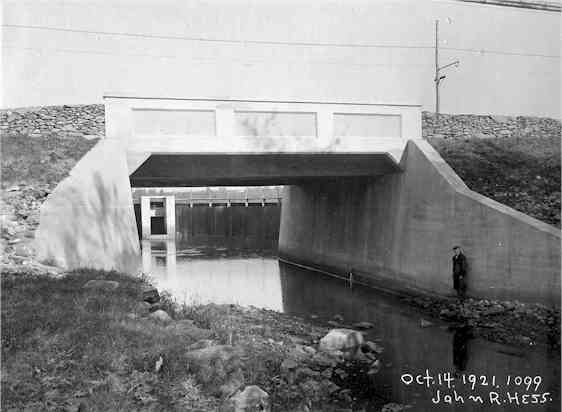
Bridge over Danielson Pike (US Route 6) in North Scituate. Note the "Horseshoe" Dam in the rear, under the bridge.
The main Scituate reservoir was formed by the construction of a dam across the Pawtuxet River at the former village of Kent. The dam, principally of earth, is about 3,200 feet long and 100 feet high. Water storage in the reservoir began on November 10, 1925. An aqueduct from the dam feeds the nearby treatment plant which was placed in operation on September 30, 1926.
The original treatment plant was state-of-the-art at the time of its construction. The plant was considered to be among the most technologically advanced of its day, and for many years the filtration system was the only plant of its type in New England. As demand continued to grow, the treatment plant underwent major expansions and renovations in the 1940's and again in the '60s. Today, the plant has a maximum treatment capacity of 144 million gallons of water per day and still remains the largest treatment facility in New England.
Once leaving the plant, water is delivered into the system through two major aqueducts. The first, the original 90-inch aqueduct constructed at the same time as the original treatment plant, is 4.5 miles long, including 3.3 miles of tunnel. It terminates at the structure called the siphon chamber, located near Phoenix Avenue in Cranston. From there, it splits into two large conduits, 60-inch and 66-inch in diameter, which in turn split into a series of progressively smaller transmission mains supplying the distribution system. The second supplemental aqueduct, constructed in the 1970s, is a 9.5 mile, 78-inch and 102-inch tunnel and aqueduct system which terminates at Budlong Road in Cranston.
Flow from the source of supply is entirely by gravity. At present, the mode of delivery within the distribution system is 75% by gravity and 25% by pumping. Four storage reservoirs located within the distribution system provide storage for fire protection, emergencies and for meeting peak demands. Two of these - the Aqueduct Reservoir in Cranston, with a capacity of 43.4 million gallons, and the Neutaconkanut Reservoir in Johnston, with a capacity of 42.1 million gallons - are on the gravity feed system. The system's three primary pumping facilities - the Neutaconkanut, Bath Street, and Fruit Hill pumping stations - supply water to the other two storage facilities, Longview Reservoir in North Providence, with a capacity of 24.8 million gallons, and Ridge Road Tank, with a capacity of 3.5 million gallons, located in the Town of Smithfield. Water is delivered to the system's 72,300 retail service connections and 8 wholesale communities through a system of 870 miles of water mains, ranging from 6" to 66" in diameter.
From Providence Water Website
Designed with Mobirise web page template